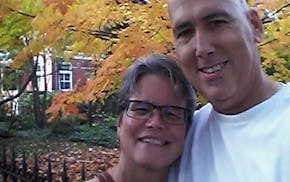The colors for Minneapolis North High School are blue and white, same as the Israeli flag. This is not a coincidence, says Jane Barrash, who has taught the school's state championship basketball team meditation, relaxation techniques and positive thinking for three years.
The Polars basketball team also plays in Jacobi gym. "It doesn't get much more Jewish than that," said Barrash, who has launched an effort to reconnect Jewish people who grew up on the North Side with their old neighborhood in an effort to "build awareness of and support for North High, and north Minneapolis more generally."
Barrash said Jews in Minnesota had a strong presence on the North Side for decades and lived and worked beside blacks in relative harmony. After riots along Plymouth Avenue in 1967, however, many Jews left the community both physically and emotionally. Barrash hopes to change that. The effort, begun last winter in meetings between North Siders and Jews who used to live there, is being celebrated Sunday at a picnic at a private home on the North Side.
"One of the initiatives is an effort to build bridges between past and present with a far more promising vision for the future," said Barrash. "The riots were bad, many emotions were hardened, and passed down. We need models of new bonds to heal old wounds. Visiting each others' homes is part of a new model."
North's basketball and football teams both had a great year, bringing lots of positive attention to a school that nearly closed for good a few years ago, but has grown to about 400 students. Barrash and basketball coach Larry McKenzie decided to leverage that good news to showcase other gains at the school and in the neighborhood.
"Since coach McKenzie first invited me to work with him to help turn the team around, I said I wanted a message of optimism to be sent out from north Minneapolis and North High to demonstrate the power we have over statistics and negative trajectories," said Barrash. "There's science behind optimism. We set out to make a new story."
McKenzie said his team winning the 2016 state crown came at a time the community had been dealing with the police shooting of Jamar Clark, and it helped it come together. He began to see former residents, both black and white, coming to North's games, often wearing their letter jackets. He and Barrash began talking about how they could get some of those people to show up for more than games.
"I think the biggest thing I hope to do is to change the narrative," said McKenzie, whose team had nine of 12 players on the "A" or "B" honor roll. "We need as many people who grew up on the North Side as possible to know about all the positive stuff going on here."
Odell Wilson has lived in the neighborhood for 25 years, but had a hard time convincing his daughter to attend North because of a bad reputation and stereotypes.
"I said, 'Even if some of these things are true, why can't you be the one who goes into that school and makes things better? If you meet kids in trouble, you can help them. Who is going to change the perception of the school and neighborhood?' " Wilson said.
Wilson's daughter excelled at North and is now in college, as are many of her friends. His son is now on the school's basketball and football team, which also went to the state tournament last year.
While sports brought some alumni back, Wilson wants to keep them attached to the school and neighborhood in other ways. Plans include naming a North Side resident of the year and having student athletes teach younger kids positive "mind-body" approaches to problem solving.
"How can we connect all this?" said Wilson, who supervises federal probation officers. "Maybe somebody wants to tutor. Maybe somebody wants to do motivational speaking or give them internships. It's an evolving thing, but I think it can be something great. Let's show everyone that people who are successful came from north Minneapolis."
One of those involved is Marshall Tanick, a Twin Cities attorney who graduated from North High in 1965. When he attended North, about 25 percent of the students were Jewish and 25 percent were black. He's maintained some relationships and done business in his old neighborhood, but many of his Jewish friends have not. Tanick said he's been to the school and was impressed with the kids and the educational and athletic successes of the past couple of years.
"We got along really well," said Tanick. "It was the classic melting pot, more so than anywhere else in the Twin Cities. But white flight happened really rapidly."
Coming back to the old neighborhood is "more than just nostalgic," said Tanick. "We are just in the organizing stage, but we want to get people interested in coming back to revitalize the area."
jtevlin@startribune.com • 612-673-1702
Follow Jon on Twitter: @jontevlin

Tevlin: 'Against all odds, I survived a career in journalism'

Tevlin: Grateful Frogtown couple fight their way back from fire and illness



